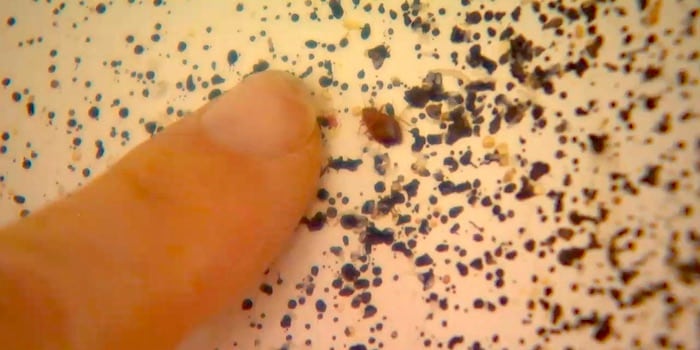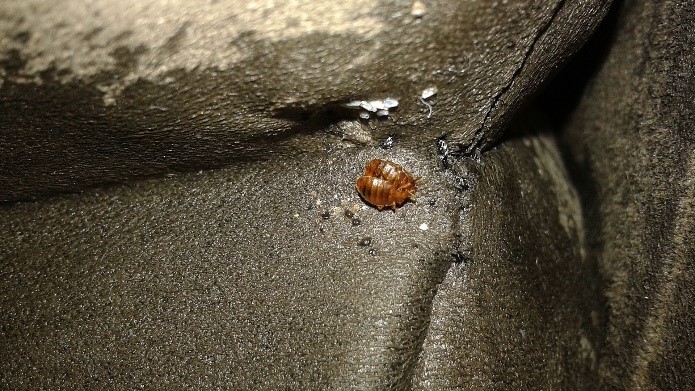Bedbugs
Bedbugs are small insects that often live on furniture or bedding. Their bites can be itchy, but do not usually cause other health problems.
Bedbugs can hide in many places, including on bed frames, mattresses, clothing, furniture, behind pictures and under loose wallpaper.
Signs of bedbugs include:
bites – often on areas exposed while sleeping, like the face, neck and arms
spots of blood on your bedding – from the bites or from squashing a bedbug
small brown spots on bedding or furniture (bedbug poo)
How you can treat bedbug bites
Bedbug bites usually clear up on their own in a week or so.
Things you can do include:
putting something cool, like a clean, damp cloth, on the affected area to help with the itching and any swelling
keeping the affected area clean
not scratching the bites to avoid getting an infection
You can ask a pharmacist about:
using a mild steroid cream like hydrocortisone cream to ease bedbug bites (children under 10 and pregnant women should get advice from a doctor before using hydrocortisone cream)
antihistamines – these may help if the bites are very itchy and you’re unable to sleep

How to get rid of bedbugs
Do
contact your local council or pest control service – it’s unlikely you’ll be able to get rid of bedbugs yourself because they can be resistant to some insecticides
wash affected bedding and clothing – use a hot wash (60C) or tumble dry on a hot setting for at least 30 minutes
put affected clothing and bedding in a plastic bag and put it in the freezer (-16C) for 4 days (alternative to hot washing)
clean and vacuum regularly – bedbugs are found in both clean and dirty places, but regular cleaning will help you spot them early
How to Get Rid of Bed Bugs
Bed bugs are pests that are tough to get rid of. They’re really good at hiding, and they reproduce quickly. Plus, bed bug eggs are resistant to many forms of treatment, so a one-time treatment might not be enough to get rid of your bed bug problem.
If you think you might have bed bugs, don’t burn the entire house down just yet. We’ll walk you through how to get rid of bed bugs, including where to find them, what they look like and how to get rid of them for good.
How Do I Get Rid of Bed Bugs?
It might be tempting to fly into a bed bug killing rage and start spraying everything in sight. Although it might feel good in the moment, doing that is a waste of time and money. When you live with a lot of clutter, this makes it easier for bed bugs to hide and harder for you to get rid of them. Since things like books, children’s items, boxes, and electronics can’t be treated with insecticides, bed bugs end up with plenty of places to hide for safety. Clean up cluttered areas before treating with chemicals.
Get Rid of Clutter
Get anything except for large furniture out of the room. Items from the infested area can transfer bed bugs to other areas of the house, so you should store them in tightly sealed plastic bags with Nuvan Strips to kill any bed bugs.
Wash Infested Clothes & Bedding
Infested clothes and bedding can’t be treated with insecticide. Wash them in hot water that’s at least 120°F in order to kill any bed bugs. You might want to run them through twice, just to be sure.

How to Get Rid of Bed Bugs at Home
Bed bugs are troublesome to deal with. If you fail to eliminate even a single pregnant bed bug, your household runs the risk of getting infested with over 300 adult bed bugs and 1000 eggs in less than three months.
Bed bugs are common household pests that are oval in shape and brownish in colour. They are parasites that live on the blood of humans and animals.
Immature bed bugs are known as nymphs. Nyphms shed their skin five times before becoming mature. They need a complete meal of blood before each shedding. These nymphs require a little less than a month to develop fully and produce three generations of offsprings in a year, under favourable conditions.
So, where do these pesky pests come from? Bed bugs can enter your home (and life) through clothes, luggage, couch, beds, and mattresses. They have a flattened body and can fit into any available space are hard to detect. They do not have nests but live in groups. Bed bugs initially hide in mattresses, headframes, box springs and places from where they will have easy access to sleeping people, and feed on them. They later spread to other places.
How to Remove Bed Bugs?
These small bloodsuckers can create havoc in your life if not eliminated completely. It is not difficult to remove bed bugs. A little bit of patience and knowing what needs to be done, can help in removing these tiny pests.

How To Get Rid of Bed Bugs
Getting rid of bed bugs can be beyond miserable. Emotionally miserable. Psychologically miserable. Financially miserable. What makes bed bugs particularly exhausting to get rid of is their ability to avoid pesticides for extended periods of time and continually regenerate their populations. Sometimes the bed bug problem starts to feel hopeless, like the infestation simply will never end.
Inspect. Inspect. Inspect. Inspect.
Get the idea? When dealing with bed bugs, a complete, comprehensive inspection is the key. Inspecting for bed bugs is not easy, meaning even the most skilled bed bug inspectors can miss finding the presence of bed bugs. Equip yourself with a quality flashlight and be prepared to examine all cracks, crevices, joints, folds, and other tight spaces anywhere bed bug activity may be suspected.
Monitor. Inspect. Monitor.
Get your bed bug monitoring program in high gear. If you weren’t able to find any evidence of bed bugs during your inspection, monitors will drastically enhance your inspection efforts. Use a combination of monitors in various locations and inspect the monitors daily.
Act Quickly. Time is of the Essence
Once you’ve confirmed the presence of bed bugs, don’t delay. Whatever evidence you discovered is likely to be representative of a much larger bed bug problem. Although bedbugs may be slow to reproduce as compared to some other insects, each adult female can produce about one egg per day which takes about 10 days to hatch. Left unresolved, bed bug problems can get out of hand rather quickly.
Vacuum. Declutter. Clean. Vacuum
Start eliminating things in the environment that might create cover for bed bugs, and vacuum floors, carpets, beds, mattresses, cracks, and anything else you can find. Discard the contents in a sealed container away from the home. Vacuuming is an excellent way to immediately remove bed bugs from the area, as compared to some pesticide applications which may produce slower results.
How to Get Rid of Bed Bugs
Lately, there has been a resurgence of bed bugs, and more and more people are looking for means and ways of getting rid of bed bugs permanently. In this post, we look into the options you have when dealing with these bugs. Similar to dealing with other pests the best course of action to take is to combat bed bugs in the very early stages of infestation.
When dealing with bed bugs, commercial insecticides are an option. Chemical insecticides are readily available and reasonably effective, however, in many cases, it may not be enough to eradicate bed bugs and their eggs. In many cases your best option is to call pest controllers for professional assistance. There are a lot of factors that can make it challenging to kill bed bugs in the home. There’s the challenge in detecting them, identifying them, finding their hiding places, and their growing resistance to different commercial insecticides or pesticides.
When treating bed bugs it is important to strategize and understand the different methodologies available for you to be able to maximize them to exterminate them successfully. This article gives you a comprehensive guide on how you can effectively identify bed bugs, how to eliminate them and prevent resurgence.
How to Detect and Identify Bed Bugs
Finding and identifying bed bugs can be challenging since they are tiny in size and can hide in small cracks or spaces in your home. But traces or evidence of bed bug infestation can be seen on your beddings, mattresses or areas where you usually sleep. Bed bugs usually leave chunks of dark brown or black spots on surfaces, these spots are dried excrements. There is also a distinct smell which is subtle, sweet, musty odour.
Bed bugs usually thrive in places where you spend a lot of time sleeping. They have tiny, flattened bodies and they get into small cracks or crevices in the home. They cluster together in places like mattresses, headboards, box springs, foot boards, bed frames, and any furniture near the bed. They also stay inside cracks or small spaces or gaps behind wall outlets or sockets, floor, door or window moulding. They can also be found in carpet edges in some cases.